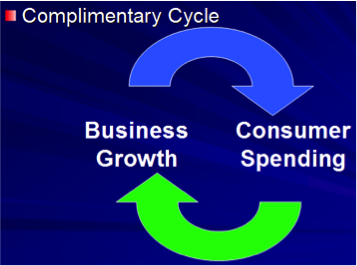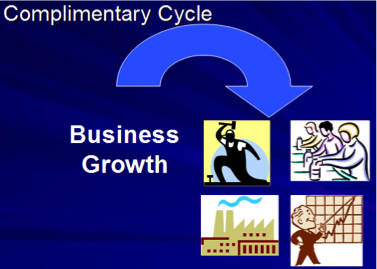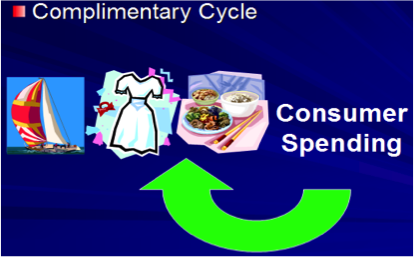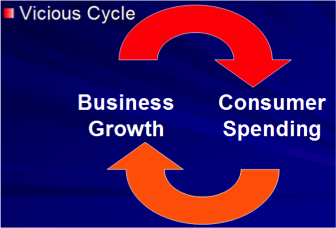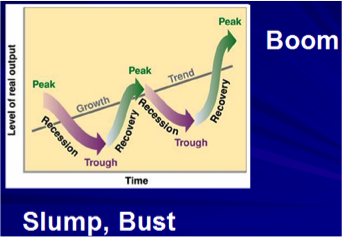Policy Instruments
Recap on government economic policy instruments
-
Governments have a great deal of economic power – 35% of GDP is outflowed as taxes!
-
Governments can also pass laws which affect business – e.g. environmental laws or minimum wage.
-
Business managers need to know how the government economic decisions can affect it – they need to be proactive and see opportunities rather than threats.
Government objectives
At times there maybe a conflict of interest. For example, a government desire to plug the deficit by reducing government spending. But at the same time, they also desire to reduce unemployment.
Labour = spend money to make money. Conservative = plug the deficit for a more stable future economy. Irrespective of your political allegiance: which option do you think is better?
Most government has four principal objectives:
-
Sustained economic growth, to raise standards of living and wealth
-
Stable prices – inflation causes uncertainty and problems (domestically as well as global competitiveness).
-
High level of employment which will increase social welfare. Reducing U/E can increase productive efficiency and reduce welfare expenditure/poverty.
-
A sustainable position on B of P. If I>E a trade deficit builds up and money is flowing out of the UK economy. The British £ is not in as much demand and its value falls thus ER depreciates, creating instability and uncertainty.
The 4 Government Economic Policies are: F, M, S-S, and ER!
Expansionary policies – to grow the UK economy! This can include such action as lower interest rates, tax cuts and __increase in __public expenditure.
Contractionary (deflationary) policy – to slow down the UK economic growth rate. This can be put in place if the UK economy is growing too fast leading to high inflation, or if it is growing unsustainably. This can include such action as raise interest rates, tax increases __and expenditure __cuts.
__Policy conflicts - __The government whilst seeking to manage economic affairs may have to accept trade-offs.
A trade-off occurs when two objectives cannot be achieved – the more you have of one, the greater the opportunity costs in terms of the other. Informally, a long-term OC.
E.g. high U/E is a price to pay in order to keep inflation in check. But if we use expansionary policies to reduce U/E then inflation will rise, thus people will turn to imports and this is bad news for B of P! Either way a trade-off occurs.
Policies have to be tailored to achieve a reasonable balance between all objectives – the government truly has a difficult juggling job! Recently, with the global recession hitting the UK hard, the gov have placed greatest emphasis on principal objective number 1: stimulating economic growth.
The 4 governments economic policies areas
Fiscal, Monetary, Supply-side & Exchange rate
Fiscal Policy: Government Financial Policy
All governments spend money. What do they spend money on? This can provide opportunities for businesses – e.g. construction, weapon manufacturers, bus manufacturers, etc.
Governments raise money through taxes on individuals and businesses. What are the main types?
- Direct Taxes = income of businesses and individuals – e.g. corporation tax and income tax.
- Indirect Taxes = taxes on spending – e.g. VAT or import tariffs.
Monetary policy - Interest Rates
What if there were higher interest rates on loans?
-
Firms with existing loans would have to pay more in interest to the bank. This would reduce their profit, so less profit is reinvested and sent to the owner.
-
Managers thinking about borrowing money to expand their business will delay. People hoping to start a new business might be put off and can no longer afford to.
-
If consumers have mortgages (big loans used to buy a house) then higher interest payments will reduce their disposable income. Thus consumer spending and demand will fall.
-
As consumer demand falls – major luxury items that would usually be bought with a loan (such as cars and houses) will be affected. These businesses may have to reduce output and make workers redundant.
-
Though higher interest rates in a country will encourage foreign banks and individuals to deposit their money in that country’s banks (for they will earn more interest on their capital!). By switching their money into £ they are raising demand for it – thus raising its price!
Supply Side Policies
Governments want to have an efficient and competitive economy. Naturally they want businesses to expand, produce more and employ more workers (this is good for the country as a whole!). Supply side policies are policies that the government has to try to improve the efficient supply of goods and services, raise aggregate supply and productivity.
-
Deregulation – reduce bureaucracy and paperwork that makes business inefficient and adds to costs!
-
Privatisation – What is it? When a business is sold off by the government from the public sector, to a private owner in the private sector and competition is allowed to form. E.g. BT It is now very common to try to open up competition in industries and improve efficiency.
-
Improving training and education – To improve the country’s skill sets. E.g. The computer industry is now short on skilled staff.
-
Increase competition in all industries – this maybe achieved by reducing government controls over an industry or by acting against monopolies (markets where one firm controls it – you could say Coca-cola has a monopoly in the soft drinks industry)
-
Improving market incentives – tax cuts/incentives; Some politicians favour tax cuts, expecting this will encourage people to work harder and thus increasing supply to the market. Tax credits ensure that everyone is better off working than surviving on benefits.
Exchange Rate Policies
Policy designed to manipulate a country’s currency into either a WPIDEC or SPICED scenario to suit a country’s import/export trend.
Macroeconomic problems and policies
The recession that developed in 2008 was triggered by the ‘credit crunch’ via a global banking crisis. In the UK the gov took a major stake in several banks and significantly increased government expenditure. Struggling firms in key industries (e.g. car manufacturing) were given financial assistance to prevent their failing.
It all goes back to the complimentary or vicious cycle of an economy. Consumer expenditure = demand for goods/services = profit. This finances the factors of production (CELL) that are used to run a business. One of the factors is labour = income for households = expenditure on consumer goods….and the cycle goes round again!
The onset of the 2008 recession/banking crisis frightened consumers – so they quickly cut back on spending in order to save more (a leakage in the cycle!) as people were worried they would lose their jobs!
Savings rise = consumer expenditure falls = reduced aggregate demand = bad for businesses and the feared cut backs happen. Output falls and U/E rises - a vicious cycle!
What makes economies grow?
Economic growth is an increase in the real level of national output. It is measured by percentage change in GDP. It can bring significant benefits such as higher standards of living and increased employment opportunities.
Stimulating economic growth has three important aspects:
-
There must be sufficient aggregate demand to make it worth producing more. If aggregate demand is < capacity output, there’s little point!
-
In the long run it maybe necessary to increase the productive capacity of the economy – long run aggregate supply. This can include increasing the factors of production (CELL), capital investment (equipment) and labour productivity (via education and training).
-
Innovation and technological change can also aid aggregate supply.
In a healthy free market economy, many features of economic growth will develop on their own as producers respond to the profit-signalling mechanism (profit motivated).
Increasing inputs
Less often, a simple increase in the quantity of inputs can make a difference. While aggregate demand was growing in the UK, immigration stimulated production by providing an easily available source of labour – including many people with skills that were scarce in the UK. Although it is not as easy to increase the quantity of land.
What can the government do?
In favourable circumstances, economic growth can happen on its own. But market failure (failure to allocate resources efficiently) can be a big impediment to growth and governments can act to reduce distortion. They can also help the growth process along in other ways.
-
Firms that restrict markets can be controlled via regulation and competition policy
-
Inadequate education/training can be addressed by providing appropriate merit goods. Governments have a role to play in ensuring that skilled people are available when needed, by investing in higher education and work based training.
In addition the gov can create incentives. They may:
-
Offer tax breaks and grants to stimulate investment.
-
Fund R&D to facilitate technological improvements and process innovation. This may help UK firms to develop a comparative advantage in the world economy.
-
In order to maximise productive potential, labour flexibility needs to be encouraged. Typically employees in the UK expect to move jobs 3 times in a working life!
All of these policies are very long term in their impact; many would be classed as S-S.
Can the economy be turned around in a recession?
Ideally the government would like the economy to grow in a sustainable way. Gordon Brown was pretty good at this! But economic growth might be too fast. Or it might be negative - a recession, where aggregate demand falls, profits are depressed and businesses reduce output and make workers redundant.
Falling output – negative growth – herald the call for expansionary policies but these may have a multiplier effect. Government spending on capital projects (new schools/hospitals/roads) may lead to increased sales of building materials/construction equipment/employment. Workers receive income which they spend, and the cycle turns complimentary again.
Stabilisation Policy
Economies are cyclical and you could say that recessions are inevitable – the cycle of boom/bust is simply how economies work. It is impossible to say what would have happened if the banking system had avoided collapse in 2008, but a recession was due anyway!
The economy is clearly vulnerable to shocks and it is hard to predict events accurately. The Irish economy is a good example (Google a graph of its growth in the 90s/00s! A staggering 350% increase), was overheating from such a massive boom long before the fall in housing prices in the US undermined the banks on a global level.
Managing the economic cycle
During a boom, aggregate demand is growing strongly and businesses respond by investing. Inflation may occur. Employers will be searching for people with scarce skills and wages might be pushed up.
The threat of inflation will trigger moves to reduce aggregate demand. Initially the objective will be to make demand grow less fast – to prevent the economy from overheating. This has been the ‘sustainable approach’ of Mr Brown and the MPC during the ‘naught-ies’ prior to 2008.
Recession
A recession will affect firms in different ways. Demand may fall and cash flow will suffer. Businesses may try to cut costs (thus redundancies and outsourcing). Firms will be increasing dependent on external sources of finance and adversely affected by MPC interest rate changes.
Profits may fall, reducing retained profits and investment. Firms maybe reluctant to invest when demand is falling anyway. Suppliers will be affected too. Firms in construction and engineering sectors are especially vulnerable.
All of these trends are, collectively, going to reduce aggregate demand further!
Stabilisation policies
A key aim of gov policies is to keep the economy stable. Cyclical fluctuations increase uncertainty and make it harder for businesses to plan for the future. They prevent governments from reaching their 4 macro-economic objectives.
Contractionary policies will be used to tackle a boom if an economy is overheating. This will, of course, slow down economic growth – but if implemented at the correct time will make that growth sustainable in the long-run.
Expansionary policies will be used to stimulate an economy that is stagnating. Subsequently aggregate demand will be moderately increased. For an economy which is actually in recession (defined officially as two consecutive quarters of falling output) the expansionary measures should be more robust.

